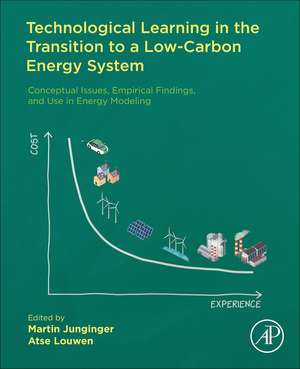Technological Learning in the Transition to a Low-Carbon Energy System: Conceptual Issues, Empirical Findings, and Use, in Energy Modeling
Editat de Martin Junginger, Atse Louwenen Limba Engleză Paperback – 22 noi 2019
For each technology, current market trends, past cost reductions and underlying drivers, available experience curves, and future prospects are considered. Electricity, heat and transport sector models are explored in-depth to show how the future deployment of these technologies—and their associated costs—determine whether ambitious decarbonization climate targets can be reached - and at what costs. The book also addresses lessons and recommendations for policymakers, industry and academics, including key technologies requiring further policy support, and what scientific knowledge gaps remain for future research.
- Provides a comprehensive overview of trends and drivers for major energy technologies expected to play a role in the energy transition
- Delivers data on cost trends, helping readers gain insights on how competitive energy technologies may become, and why
- Reviews the use of learning curves in environmental impacts for lifecycle assessments and energy modeling
- Features social learning for cost modeling and technology diffusion, including where consumer preferences play a major role
Preț: 575.47 lei
Preț vechi: 735.48 lei
-22% Nou
Puncte Express: 863
Preț estimativ în valută:
110.13€ • 114.55$ • 90.92£
110.13€ • 114.55$ • 90.92£
Carte tipărită la comandă
Livrare economică 08-22 aprilie
Preluare comenzi: 021 569.72.76
Specificații
ISBN-13: 9780128187623
ISBN-10: 012818762X
Pagini: 340
Dimensiuni: 191 x 235 x 17 mm
Greutate: 0.59 kg
Editura: ELSEVIER SCIENCE
ISBN-10: 012818762X
Pagini: 340
Dimensiuni: 191 x 235 x 17 mm
Greutate: 0.59 kg
Editura: ELSEVIER SCIENCE
Public țintă
Early career researchers studying energy technologies. Energy system modelers. Energy economists. Utilities, technology manufacturers, grid operators. Policy makers involved in energy policy.Cuprins
Part I
1. Introduction
2. The Experience Curve: Concept, History, Methods and Issues
3. Implementation of Experience Curves in Energy energy-system models
4. Application of experience curves and learning to other fields
Part II Case Studies
5. Photovoltaic solar energy
6. Onshore wind energy
7. Offshore wind energy
8. Grid-scale energy storage
9. Electric Vehicles
10. Power to gas (H2): alkaline electrolysis
11. Heating and cooling in the built environment
12. Concentrating solar power
13. Light-emitting diode lighting products
Part III Application of Experience Curves in Modeling
14. Experience Curves in Energy Models by Lessons Learned from the REFLEX project
15. Global electric car market deployment considering endogenous battery price development
Part IV Final words
16. Synthesis, conclusions, and recommendations
1. Introduction
2. The Experience Curve: Concept, History, Methods and Issues
3. Implementation of Experience Curves in Energy energy-system models
4. Application of experience curves and learning to other fields
Part II Case Studies
5. Photovoltaic solar energy
6. Onshore wind energy
7. Offshore wind energy
8. Grid-scale energy storage
9. Electric Vehicles
10. Power to gas (H2): alkaline electrolysis
11. Heating and cooling in the built environment
12. Concentrating solar power
13. Light-emitting diode lighting products
Part III Application of Experience Curves in Modeling
14. Experience Curves in Energy Models by Lessons Learned from the REFLEX project
15. Global electric car market deployment considering endogenous battery price development
Part IV Final words
16. Synthesis, conclusions, and recommendations
